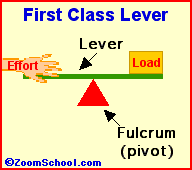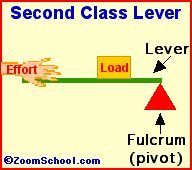Early Inventors and Inventions: the 1300s and earlier.
Archimedes (287-212 BC) was a prolific ancient Greek mathematician. Archimedes invented the water screw, a device for raising water using an encased screw open at both ends. The screw is set an an angle, and as the screw turns, water fills the air pockets and is transported upwards. The Archimedes screw is still in use today. Among his many accomplishments was the first description of the lever (around 260 BC). Levers are one of the basic tools; they were probably used in prehistoric times. Many of our basic tools use levers, including scissors (two class-1 levers), pliers (two class-1 levers), hammer claws (one class-1 lever), nutcrackers (two class-2 levers), and tongs (two class-3 levers).



An astrolabe is an instrument that was used to determine the altitude of objects in the sky (like the sun or stars). It was first used around 200 B.C. by astronomers in Greece. The astrolabe was replaced by the sextant.
The catapult is a device that hurls heavy objects or arrows over a large distance. It was invented in ancient Greece in 399 BC by Dionysius the Elder of Syracuse. The Romans later added wheels to the catapult to make it more maneuverable. The catapult (also called the ballista) was a major weapon of warfare for well over a thousand years. A double-armed catapult (also called the trebuchet) was invented by Mariano Taccola of Siena during the Middle Ages, about AD 1400.
The earliest-known compass dates from China, during the Han Dynasty (2nd century BC - 2nd century AD). This early compass was made from lodestone, a naturally-magnetic variety of magnetite ore. A spoon-shaped piece of lodestone was placed upon a bronze disk, and the lodestone always pointed north. This early compass was not used for navigation at first; it was used for divination (like Feng Shui), to determine fortuitous placement of buildings, etc.
The catapult was invented in ancient Greece (in 399 BC) by Dionysius the Elder of Syracuse. The catapult is a device that hurls heavy objects or arrows over a large distance. The Romans later added wheels to the catapult to make it more maneuverable. Also called the ballista, this device was a major weapon of warfare for well over a thousand years. A double-armed catapult (also called the trebuchet) was invented by Mariano Taccola of Siena during the Middle Ages, about AD 1400.
ASSES Eyeglasses with convex lenses for correcting farsighted vision were probably invented in Italy around the year 1268-1284, perhaps by Salvino D’Armate of Pisa or by Alessandro Spina of Florence. Early glasses were also made in China around the same time. The earliest glasses did not have arms; they perched on the bridge of the nose. Eyeglasses with concave lenses for nearsightedness (or myopia) were not invented until the 1400s.
Glasses with arms were invented in the 1600s. Bifocals (combining convex and concave lenses to correct both nearsightedness and farsightedness) were invented by Benjamin Franklin around 1775. Glasses with hinged arms were invented in 1752 by James Ayscough. Ayscough also made the first sunglasses (glasses with green- or blue-tinted lenses).
Polarizing filters (which are very effective at filtering out glare) were invented by Edwin H. Land (and patented in 1929). Katherine J. Blodgett (1898-1979) invented a micro-thin barium stearate lens coating that made glass completely nonreflective and “invisible” (patent #2,220,660, March 16, 1938).
Gunpowder was invented in China, probably during the 1000’s. Gunpowder is composed of about 75 percent saltpeter (potassium nitrate), 15 percent powdered charcoal, and 10 percent sulphur. The Chinese used gunpower to make fireworks and signals, and later to make weapons of war.
Gunpowder was invented in China, probably during the 1000’s. Gunpowder is composed of about 75 percent saltpeter (potassium nitrate), 15 percent powdered charcoal, and 10 percent sulphur. The Chinese used gunpower to make fireworks and signals, and later to make weapons of war.
The steam engine was invented by Heron, an ancient Greek geometer and engineer from Alexandria. Heron lived during the first century AD and is sometimes called Hero. Heron made the steam engine as a toy, and called his device “aeolipile,” which means “wind ball” in Greek. The steam was supplied by a sealed pot filled with water and placed over a fire. Two tubes came up from the pot, letting the steam flow into a spherical ball of metal. The metallic sphere had two curved outlet tubes, which vented steam. As the steam went through the series of tubes, the metal sphere rotated. The Greeks never used this remarkable device for anything but a novelty. A steam engine designed for real work wasn’t designed until 1690, when Dionysius Papin published plans for a for a high-pressure steam engine. Thomas Savery built the first steam engine in 1698. James Watt later improved the steam engine.
The kite was invented roughly 2,500 to 3,000 years ago. It originated in China, Malaysia or Indonesia (there are many claims to having invented the kite). Some people say that the earliest kites consisted of a huge leaf attached to a long string (there is a type of Indonesian leaf that is wonderful as a kite).
Levers are one of the basic tools; they were probably used in prehistoric times. Levers were first described about 260 BC by the ancient Greek mathematician Archimedes (287-212 BC). Many of our basic tools use levers, including scissors (two class-1 levers), pliers (two class-1 levers), hammer claws (one class-1 lever), nutcrackers (two class-2 levers), and tongs (two class-3 levers).



Marshmallow candy was first made by ancient Egyptians over three thousand years ago. The Egyptians made candy from the root of the marshmallow plant (Althea officinalis), a plant that grows in marshes. Today’s marshmallows do not contain any mallow root - gelatin is substituted for the sweet, sticky root.
Paper is writing material made from wood pulp or other fibrous material.
Almost 5,000 years ago, in ancient Egypt, the papyrus plant was processed and used as paper. Papyrus paper was made from thin sheets of papyrus pith that were soaked in water, pressed together with the grains at right angles, and then dried - the sticky sap of the plant made the thin sheets stick together, forming a sturdy writing surface. Papyrus (Cyperus papyrus is its genus and species) is a grass-like aquatic plant native to the Nile valley of Egypt. Our word paper comes from “papyrus.”
Paper is made by grinding plant material into a pulp, forming it into thin sheets, and drying it in a form. This process was invented in AD 105 by Ts’ai Lun, a Chinese official and member of the Chinese Imperial Court, about 2000 years ago; he originally used the waste from silk production. Early Chinese paper was made from the bark of the mulberry tree and other plant fibers.
Scissors were invented thousands of years ago (roughly 1500 B.C.) in ancient Egypt. Early scissors have been found in ancient Egyptian ruins. These early scissors were made from one piece of metal (unlike modern scissors, which are made from two cross-blades which pivot around a fulcrum). Modern cross-bladed scissors were invented in ancient Rome (roughly A.D. 100). Early scissors were used by clothes makers and barbers. Scissors were not in common use until much later, in the 1500’s (in Europe).
Silk was first made by the Chinese about 4,000 years ago. Silk thread is made from the cocoon of the silkworm moth (Bombyx mori), a small moth whose caterpillar eats the leaves of the mulberry tree.
According to Chinese legend, the first silk thread was made when the Chinese Empress Si-Ling-Chi was sitting under a mulberry tree and a cocoon fell into her tea; she noticed the strong, silky threads of the cocoon uncoiling. She then developed the use of silk.
For more information on the development of silk, click here.
The steam engine was invented by Heron, an ancient Greek geometer and engineer from Alexandria. Heron lived during the first century AD and is sometimes called Hero. Heron made the steam engine as a toy, and called his device “aeolipile,” which means “wind ball” in Greek. The steam was supplied by a sealed pot filled with water and placed over a fire. Two tubes came up from the pot, letting the steam flow into a spherical ball of metal. The metallic sphere had two curved outlet tubes, which vented steam. As the steam went through the series of tubes, the metal sphere rotated. The aeolipile is the first known device to transform steam power into rotary motion. The Greeks never used this remarkable device for anything but a novelty. A steam engine designed for real work wasn’t designed until 1690, when Dionysius Papin published plans for a for a high-pressure steam engine. Thomas Savery built the first steam engine in 1698. Watt later improved the steam engine.
The umbrella was invented thousands of years ago. The earliest umbrellas were made to shade the user from the sun (an umbrella used as a sun shade is called a parasol). Umbrellas were used as much a 4,000 years ago in ancient Assyria, China, Egypt, and Greece. The Chinese were probably the first to waterproof the umbrella for use in the rain; they used wax and lacquer (a type of paint) to repel the rain. Samuel Fox (1815 - 1887), an English inventor and manufacturer, invented the steel ribbed umbrella in 1852 (wood or whale bone had been used before this).
The yo-yo is one of the oldest toys. Yo-yo’s have been used as a toy for over 2,500 years, when the ancient Romans played with wooden and metal yo-yo’s. The word “yo-yo” may come from Tagalog language (the language of the Philippines), meaning “to come back.”
